Every new technology, from automobiles to televisions, goes through an evolutionary period as the product develops from the concept to a finished, user-focused design.
The first torches were squared-off, clunky hunks of plastic that looked more like a toy hammer than high-tech cutting equipment.
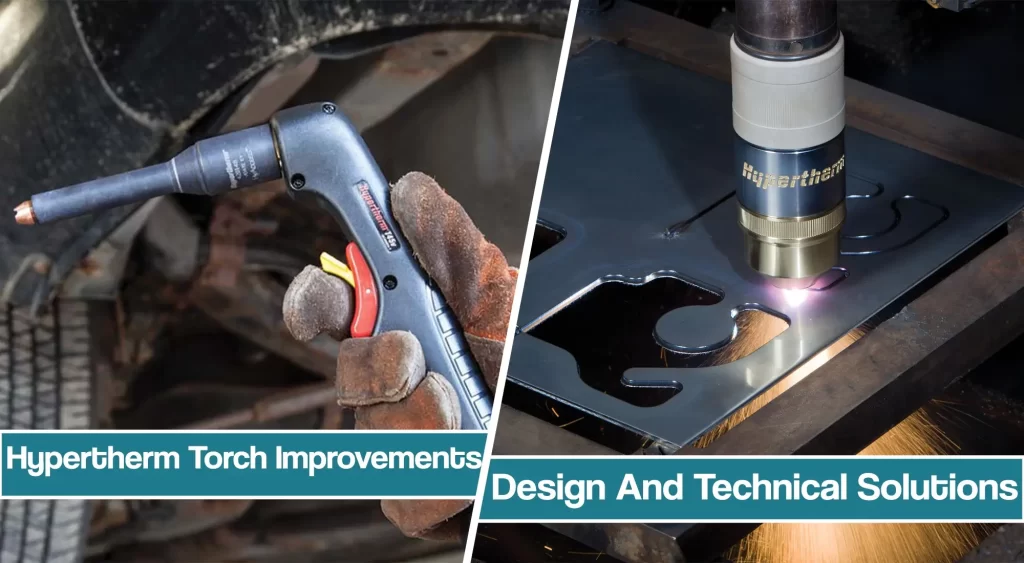
These torches did the trick when plasma cutting was in its infancy. Still, as plasma cutting and gouging evolved, it became clear that the torches needed to change to endure harsher conditions and meet a wider variety of needs.
Renowned plasma cutting machine manufacturers made sure their customers were getting the best, and that’s why we are today discussing Hypertherm plasma torch design improvements.
Early Plasma Cutting Torches – How Plasma Cutting Market Changed
Many people think that a plasma torch is only a holder for consumables. After all, these consumables in the torch that make a plasma system work:
- The electrode carries the charge necessary to create the plasma.
- The swirl ring forces the flow of the plasma into a vortex.
- A nozzle constricts and directs the plasma until it is suitable for cutting.
As a result, most early plasma-cutting technology development was centered on improving consumable design to ease the use and efficiency. In the late 1980s, the introduction of blowback torch technology eliminated the need for high-frequency starts. The shielded nozzles enabled the operator to drag the torch directly on the cut metal, which is now commonly called drag-cutting.
Operators saw immediate benefits from technological improvements. Contact-start systems eliminated interference with other shop equipment. Additionally, drag cutting resulted in smoother, easier cuts that allowed users to follow a straight edge or template. Meanwhile, other improvements focused on safety, like adding a safety trigger to eliminate accidental torch firing and a “parts-in-place” circuit to ensure consumables were properly installed before firing the torch.
The addition of quick-disconnects, like Hypertherm’s one-button FastConnect™ found on the company’s newer Powermax systems, gave operators the ability to swap torches or remove them when transporting the plasma cutter. But, even after all improvements to consumables and safety, the shape and bulk of plasma torches remained the same. Making radical changes to this design required a whole new engineering approach, which Hypertherm company applied.
Hypertherm Plasma Torch Design Improvements
That new approach came from a group of plasma engineers at Hypertherm. The company’s engineering team was determined to re-think torch design. And they knew the best way to understand the challenges their customers faced was to watch them at work.
Over the following years, engineers and product managers spent hundreds of hours on the road. They spent time discussing with numerous customers during visits to scrap yards, shipyards, and any other high-use cutting environments they dealt with.
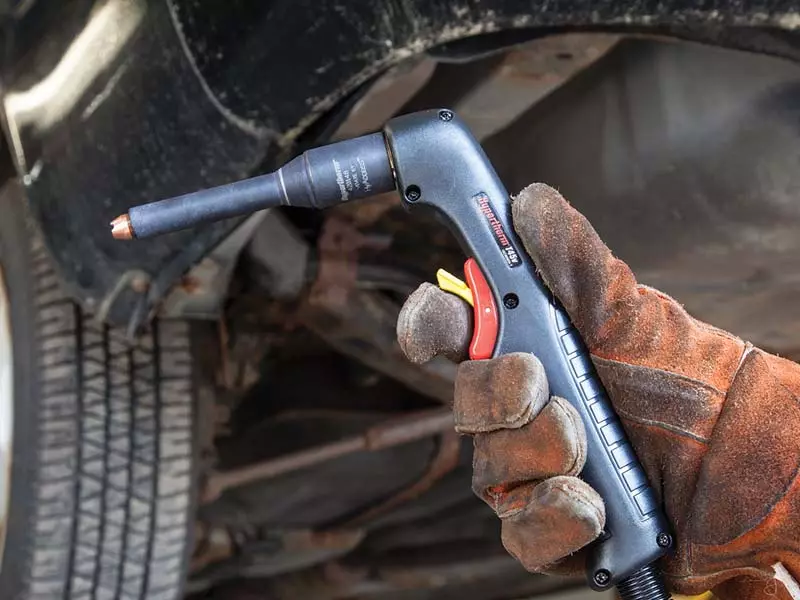
They wanted to determine how well current plasma cutting torches performed in harsh conditions and to see what welders and cutters wanted to do with plasma but couldn’t do because of design limitations.
They heard and observed that plasma cutting torches, especially hand torches, take a lot of abuse. It wasn’t uncommon to see torches accidentally falling off, getting banged against metal plates, or seared by the heat of cutting and gouging in welding. During their visits, the engineers also learned that there were a lot of jobs that operators and welders couldn’t do with a standard 90-degree plasma hand torch or full-length mechanized torch.
Focused Areas of Plasma Cutting Torch Improvement
As the result of years of research, Hypertherm engineers had plenty of ideas. However, they decided to focus on these areas:
- Creating a torch that is more durable than any other on the market;
- At the same time, they tried to make plasma torch as comfortable as possible, enhancing gouging and cutting access for tight locations;
- Robotic and pipe-cutting applications weren’t disregarded.
Everything, from the materials to the consumable design to the guts of the plasma torch, was up for review. After that, Hypertherm engineers spent two years prototyping torches and conducting heat, impact, and cut tests. Finally, they set out to find the suitable material for the torch body with complete testing.
Plasma Torch Material and Durability Improvements
To choose proper plasma torch materials, the engineers wanted to stick with plastic because it is light and easily molded.
However, they weren’t sure exactly which plastic they would use. With hundreds of different brands and compositions to choose from, the task of narrowing down the choices was not easy.
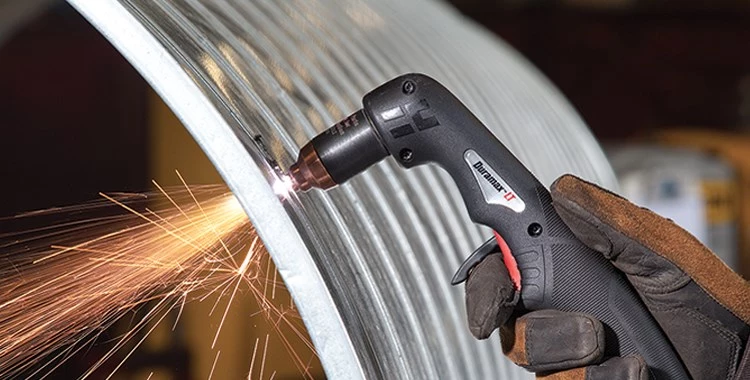
One thing that helped was the decision to turn to quantifiable measures, like the American Society for Testing and Materials (ASTM) standards for heat deflection, impact resistance, and environmental friendliness.
Based on that, the team concentrated on several plastic choices that had the best balance of properties mentioned. Then, those choices were evaluated for actual performance before a winning plastic was selected.
The challenge with designing plasma torches is they are used for cutting metal with a plastic object. Ideally, the torch handle should be made of brick and rubber simultaneously. Brick takes the heat and rubber to take the day-to-day abuse.
Improving Plasma Torch Shape
With a material selected and the durability, and objective met, the next challenge was to create a torch shaped better for gouging and cutting in tight places.
While oxyfuel users had a long array of torch angles and lengths available to them, plasma cutting torch shape has traditionally been limited by the need for an internal plunger to bring the electrode into contact with the nozzle and start the arc.
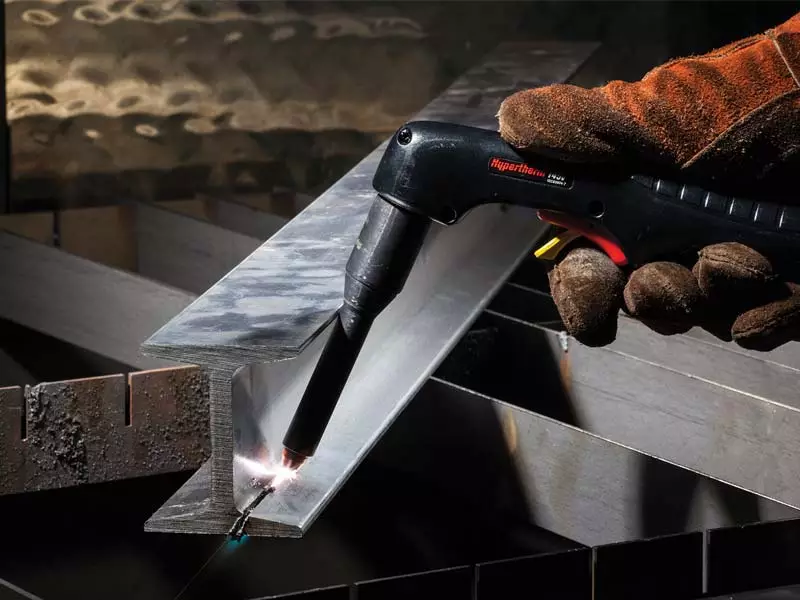
The plunger, and wires attached to it, needed room to move within the plasma cutting torch shell, restricting the choice of shapes and angles available to the engineers and therefore limiting plasma’s usefulness for specific applications.
The solution was to work from the inside out. The engineers knew they had to figure out how to remove the plunger before they could make a meaningful change to the torch’s shape. More months of work followed until the team agreed upon a solution: an entirely new consumable design that replaced the plunger in the torch with a blowback spring in the electrode.
This breakthrough technology — Spring Start™— enabled Hypertherm engineers to design a nearly straight torch that angles down just 15 degrees at the tip. Additionally, engineers managed to narrow the neck of the standard hand torch for greater visibility and to change the shape so that it could be held at either a 75-degree or 90-degree angle to the plate.
Improving Automated Plasma Cutting Torch
Having successfully met the first two challenges (creating the most robust torch available, redesigning torches for gouging and cutting in tight places), developers concentrated on the third objective: providing mechanized plasma users with the same level of innovation and flexibility available to users of handheld plasma torches.
The Hypertherm engineers noticed that the standard-length mechanized torch was often cumbersome for pipe cutting and robotic applications during their visits to plasma torch users.
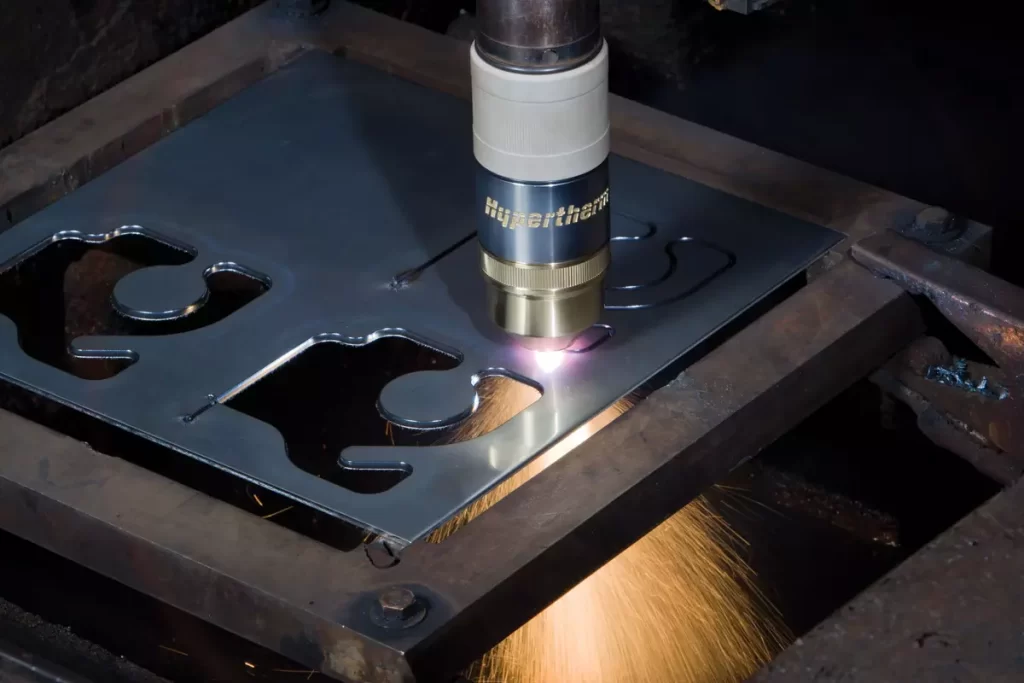
Their solution was to replace the one-piece mechanized barrel with a modular design that could convert from a long torch to a short one, easily and quickly.
Users could work either with the standard 15-inch plasma cutting torch or remove a section from the barrel to create a 6-inch mini torch, better suited for robotic applications, pipe saddles, track burners, and other applications where the extra barrel length was a problem.
Welders’ and Fabricators’ Feedback
So far, the new Hypertherm torches are getting very positive reviews. Plasma users report the straighter profile of the 15-degree torch makes cuts in corners, overhead, and tight spots much more accessible. And for plasma gouging, is incredibly revolutionary; it provides the user with more visibility and better control of the arc while keeping the operator’s hand away from the high heat generated by the gouging process.
As Hypertherm’s Jesse Roberts notes, “a fundamental change had to take place in order to advance plasma torches to the next level of reliability and versatility.”
The change is just one step in an evolutionary process. As operators find new uses for plasma cutting and gouging, plasma engineers will continue innovating along with them.





